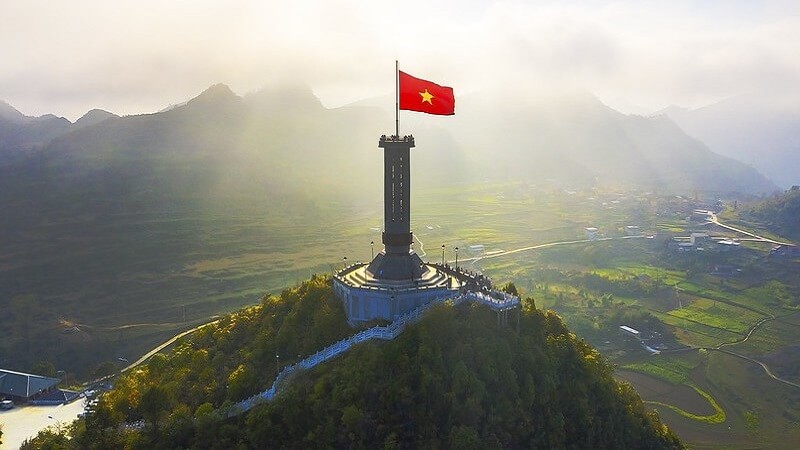Top experience you may interested in:
Explore the Majestic Lũng Cú Flag Tower in Hà Giang – A 2023 Travel Guide
When you visit Hà Giang, there’s one destination you absolutely cannot miss: the Lũng Cú Flag Tower. It holds deep spiritual significance for the people of Northeast Vietnam and serves as a crucial landmark for the country’s border. Today, let Traveloka guide you through the captivating wonders of Lũng Cú Flag Tower!
Where is Lũng Cú Flag Tower?
The Lũng Cú Flag Tower stands on the peak of Rồng Mountain in a small commune in Đồng Văn District, Hà Giang Province. Situated at an elevation of 1,470 meters above sea level, it’s one of the must-visit spots for many young travelers and a destination cherished by tourists exploring Hà Giang.
Best Time to Visit Lũng Cú Flag Tower
To reach Lũng Cú Flag Tower, you need to plan a trip to Hà Giang and organize a specific itinerary, as the tower is located about 200 km away on mountainous roads. Consider the following ideal times for a visit:
January to March: During this period, cherry blossoms, peach blossoms, and mustard flowers bloom, creating a breathtaking spectacle known as the “rock plateau in bloom.” You’ll be able to admire these beautiful flowers in full bloom.
May or June to August: These months offer dry and favorable weather for traveling and exploring Lũng Cú Flag Tower.
October to December: During this time, the region showcases the stunning triangular flower fields on the Đồng Văn rock plateau, offering picturesque views.

How to Get to Lũng Cú Flag Tower in Hà Giang
First, you need to secure a flight ticket to Hanoi. From there, you can take a coach to Hà Giang City in Hà Giang Province. Once in Hà Giang City, you can rent a motorbike or car to head to Lũng Cú Flag Tower.
If you are already in the northern provinces, you can choose to travel by coach, motorbike, or car along National Highway 4C to reach Quản Bạ, then continue to Sà Phìn Commune. From there, you can take the road leading to Đồng Văn. At the crossroads, turn towards Lũng Cú.
Keep in mind that Lũng Cú Flag Tower is located atop Rồng Mountain, so the roads leading there are winding and steep. Choose a suitable time for travel to ensure a smooth journey.
Unique Features of Lũng Cú Flag Tower
Built on the peak of Rồng Mountain, reaching Lũng Cú Flag Tower requires climbing 839 steps divided into three sections, each with resting areas for visitors to take a break and enjoy the scenery below. The tower’s architecture resembles an octagon, standing at a height of 33.15 meters, with the national flag measuring 54 square meters proudly flying at the top. Surrounding the tower’s base are bronze Dong Son drum statues depicting significant periods in the country’s history.
Standing atop the tower, you’ll feel as if you’re gazing at the southern border of Vietnam in the distance. You’ll experience the cool mountain air of Northeast Vietnam, and the sight of the sacred national flag fluttering in the wind will fill you with pride. Looking down from the summit, you’ll see two pristine blue ponds known as Mắt Rồng (Dragon’s Eyes), providing a vital water source for the Lô Lô and Mông ethnic communities.
Nearby Attractions to Lũng Cú Flag Tower
Đồng Văn Town:
Approximately 50 minutes by car from Lũng Cú Flag Tower, Đồng Văn Town, also known as Đồng Văn Ancient Town, is a must-visit location. The town’s unique architecture, more than 100 years old, showcases the distinctive and captivating style established during the French colonial period in the 1880s. The old town stretches nearly 1 km with nearly 40 adjacent ancient houses, featuring traditional pitched-roof and yin-yang tiled roofs, along with characteristic stone foundations. On full moon days, the streets are adorned with colorful lanterns, creating a magical atmosphere for the town.
Đồng Văn Karst Plateau Geopark:
Around 50 minutes’ drive south from Lũng Cú Flag Tower, the Đồng Văn Karst Plateau was designated as the first UNESCO Geopark in Vietnam on October 3, 2010, and is the second in Southeast Asia. In 2014 and 2019, UNESCO reaffirmed its status as a member of the Global Geoparks Network for the periods 2015-2018 and 2019-2022. This plateau is shared by Quản Bạ, Yên Minh, Đồng Văn, and Mèo Vạc districts of Hà Giang Province, offering a surreal and poetic landscape that will captivate every visitor.
Sủng Là Valley:
Known as the “valley of blooming rocks,” Sủng Là Valley is a must-visit destination when exploring Hà Giang, especially during the months from October to April. Here, you can witness the stunning beauty of Hà Giang in full bloom. The valley is also home to the Pao house, a significant setting in the 2005 film “Pao’s Story.” From Sủng Là Valley, you can admire the picturesque Phó Bảng intersection with its winding mountain pass and embrace the grace and simplicity of the local people and their homes.
Discover the wonders of Lũng Cú Flag Tower and its surrounding attractions during your journey to Hà Giang in 2023. Each destination will leave you in awe and fill your heart with unforgettable memories of the enchanting Northeast Vietnam.
Top must-visit attraction in Ha Giang



